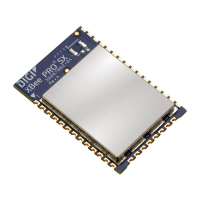Modes Modes of operation
XBee®/XBee-PRO SX RF Module User Guide
34
Transmit mode
When DigiMesh data is transmitted from one node to another, the destination node transmits a
network-level acknowledgment back across the established route to the source node. This
acknowledgment packet indicates to the source node that the destination node received the data
packet. If the source node does not receive a network acknowledgment, it retransmits the data.
For more information, see Data transmission and routing.
Sleep mode
Sleep modes allow the device to enter states of low power consumption when not in use. The
XBee/XBee-PRO SX RF Module supports both pin sleep (Sleep mode entered on pin transition) and
cyclic sleep (device sleeps for a fixed time).
Sleep modes allow the device to enter states of low power consumption when not in use. The device is
almost completely off during sleep, and is incapable of sending or receiving data until it wakes up.
XBee devices support pin sleep, where the device enters sleep mode upon pin transition, and cyclic
sleep, where the device sleeps for a fixed time.
For more information, see Sleep modes.
Command mode
Command mode is a state in which the firmware interprets incoming characters as commands. It
allows you to modify the device’s firmware using parameters you can set using AT commands. When
you want to read or set any parameter of the device when operating in Transparent mode, you have
to send an AT command. Every AT command starts with the letters AT followed by the two characters
that identify the command the device issues and then by some optional configuration values.
Command mode is available on the UART interface in both Transparent and API modes. You cannot
use the SPI interface to enter Command mode.
Enter Command mode
To get a device to switch into this mode, you must issue the following sequence: GT + CC(+++) + GT.
When the device sees a full second of silence in the data stream (the guard time) followed by the

